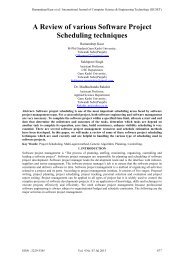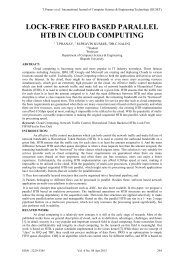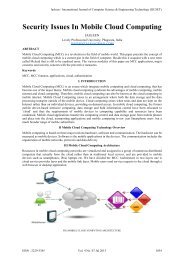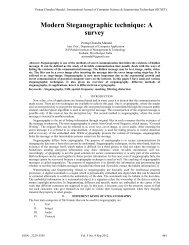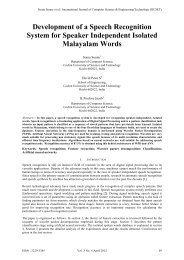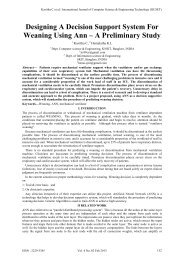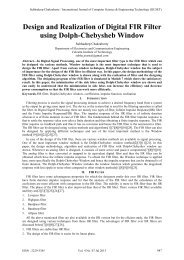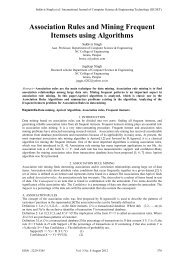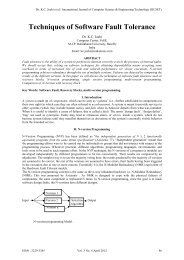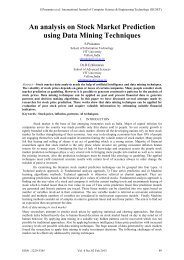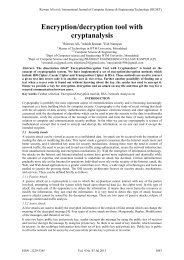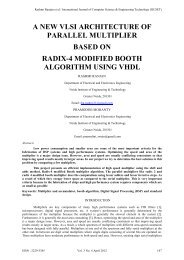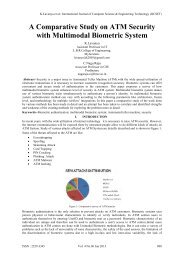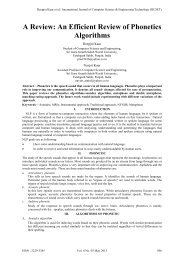a non-linear scheme for pmepr reduction in mc-cdma system - IJCSET
a non-linear scheme for pmepr reduction in mc-cdma system - IJCSET
a non-linear scheme for pmepr reduction in mc-cdma system - IJCSET
Create successful ePaper yourself
Turn your PDF publications into a flip-book with our unique Google optimized e-Paper software.
S.Tamilselvan et al./ International Journal of Computer Science & Eng<strong>in</strong>eer<strong>in</strong>g Technology (<strong>IJCSET</strong>)TABLE 1COMLEMENTARY CUMULATIVE DISTRIBUTIONFUNCTIONNo. ofIterationPMEPR(dB)0 8.7550 20By plott<strong>in</strong>g the maximum PMEPR <strong>for</strong> a normalised s<strong>in</strong>e pulse, an attractive result was ga<strong>in</strong>ed. It can beobserved that the normalisation of s<strong>in</strong>e pulses have brought PMEPR levels lower than the unmodified s<strong>in</strong>epulse. The maximum PMEPR has changed considerably achiev<strong>in</strong>g a greater rate of PMEPR <strong>reduction</strong> per ‘n’.This implies that lower<strong>in</strong>g the energy of the pulses has direct impact on the lower<strong>in</strong>g of PMEPR.SNR(dB)1 7.5660 19.42 6.8031 17.43 4.8830 16.34 4.1113 15.9Figure 3 CCDF plots of each iterationAn OFDM modulation with N=64 subcarriers and an M-QAM constellation, with a Gray mapp<strong>in</strong>g rule, oneach subcarrier is considered. The set of multiply<strong>in</strong>g co efficient{Gk; k=0,1,2,…N’-1} has a trapezoidal shape,with Gk=1 <strong>for</strong> the N data subcarriers (<strong>in</strong>-band region), dropp<strong>in</strong>g <strong>l<strong>in</strong>ear</strong>ly to 0 along the first (N1-N)/2 out-ofbandsubcarriers at both sides of the <strong>in</strong>-band region, which means N1 <strong>non</strong>zero subcarriers. The <strong>non</strong><strong>l<strong>in</strong>ear</strong>operation is chosen to be an ideal envelope clipp<strong>in</strong>g .On consider<strong>in</strong>g the basic, s<strong>in</strong>gle-iteration signal-process<strong>in</strong>g <strong>scheme</strong>s, Figure 4 is concerned with thebandwidth-efficiency issues when us<strong>in</strong>g these <strong>scheme</strong>s, with a clipp<strong>in</strong>g level of 2.0. A well-known PSD-relatedfunction was adopted: the so-called fractional out-of-band power (FOBP), def<strong>in</strong>ed <strong>for</strong> a symmetrical PSD.Clearly, this clipp<strong>in</strong>g can lead to high out-of-band radiation levels.However, by us<strong>in</strong>g a frequency-doma<strong>in</strong> filter<strong>in</strong>g with Gk=1 <strong>for</strong> the data subcarriers and 0 <strong>for</strong> the rema<strong>in</strong><strong>in</strong>gones (i.e.) we can reduce these levels to those of conventional MC-CDMA. Further <strong>reduction</strong> is achieved if thisfilter<strong>in</strong>g is comb<strong>in</strong>ed with the w<strong>in</strong>dow<strong>in</strong>g procedure.ISSN : 2229-3345 Vol. 3 No. 3 March 2012 18



